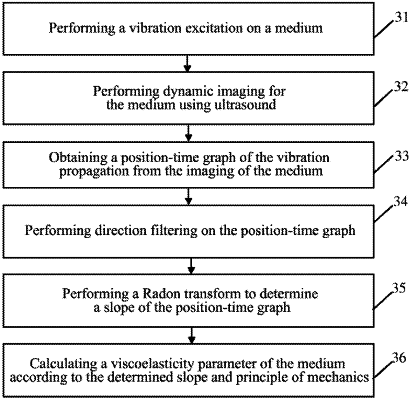| CPC G01N 11/16 (2013.01) [A61B 8/0858 (2013.01); A61B 8/485 (2013.01); A61B 8/5207 (2013.01); G06T 7/40 (2013.01); G01N 2203/0094 (2013.01)] | 5 Claims |

|
1. A method for quantifying viscoelasticity of a medium, wherein the method comprises:
generating, by an exciting device, a vibration excitation on the medium to make the medium generate vibration and make the vibration propagate in the medium;
performing, by an imaging device, imaging for the medium after the vibration excitation is generated by virtue of a detection wave of the imaging device;
obtaining, by the imaging device, a position-time graph of vibration propagation along a set vibration propagation direction from dynamic imaging of the medium, wherein a horizontal axis of the position-time graph indicates time, and a vertical axis of the position-time graph indicates a position of wave-front of the vibration;
performing angle projection along directions having respective angles relative to a preset line of 0 degree on the position-time graph to determine a slope of the position-time graph corresponding to an angle with maximum signal energy, wherein the respective angles are within a preset angle range; and
obtaining, according to the slope, propagation velocity of the vibration, and determining, according to principle of mechanics and the propagation velocity of the vibration, a viscoelasticity parameter of the medium;
wherein the performing the angle projection along the directions having respective angles relative to the preset line of 0 degree on the position-time graph to determine the slope of the position-time graph corresponding to the angle with maximum signal energy, comprises:
performing integral calculation along each angle within the preset angle range on the position-time graph, wherein the integral calculation is Radon transform;
determining an angle corresponding to a maximum integral value obtained by the Radon transform as a slope angle of a slope line of the position-time graph; and
determining the slope of the slope line using the slope angle.
|